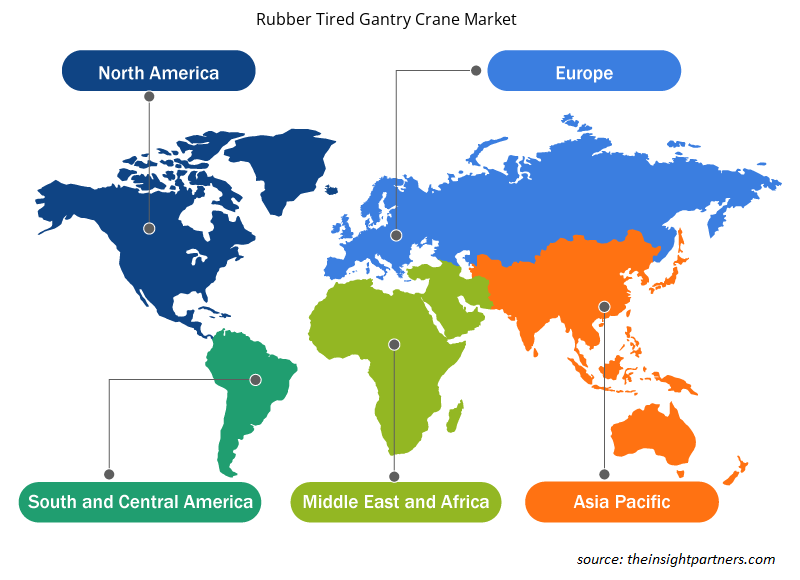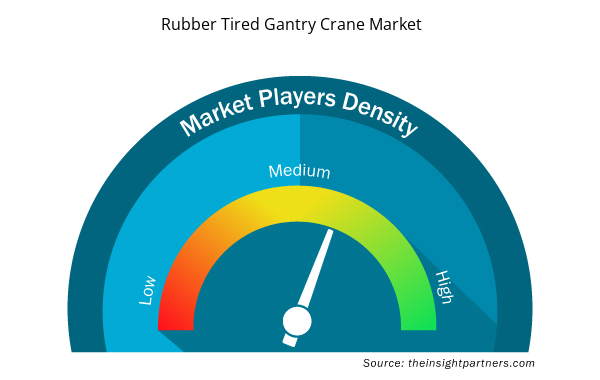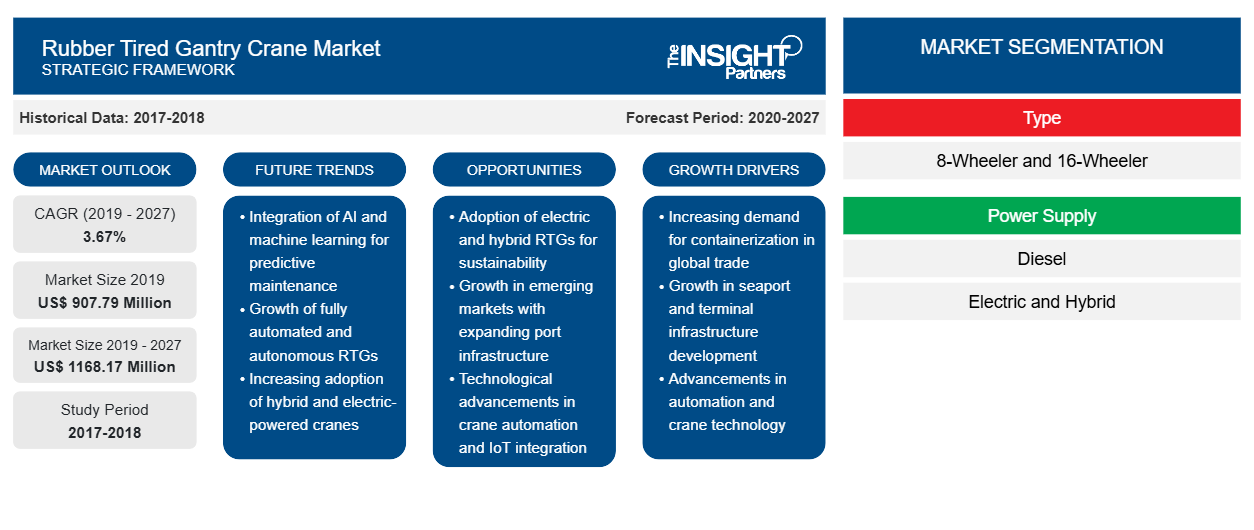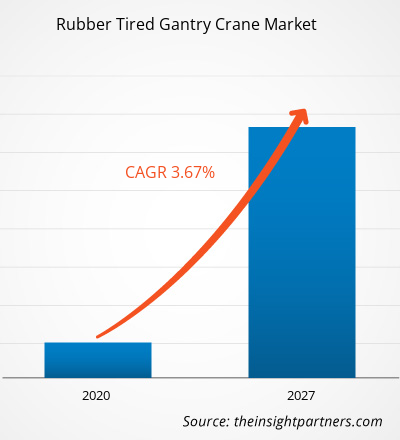El mercado de grúas pórtico con neumáticos se valoró en USD 907,79 millones en 2019 y se proyecta que alcance los USD 1168,17 millones para 2027; se espera que crezca a una CAGR del 3,67% entre 2020 y 2027.
En el pasado, los países en desarrollo eran proveedores de materias primas; sin embargo, la distribución del comercio ha otorgado un nuevo papel a los países en desarrollo en todo el mundo, por lo que se prevé que el mercado de grúas pórtico con neumáticos experimente una tasa de crecimiento significativa durante el período de pronóstico. El crecimiento del mercado se atribuye principalmente al aumento de la demanda de comercio marítimo, ya que los países en desarrollo, incluida China, ahora están surgiendo como importantes importadores y exportadores de bienes por mar, siendo Asia la región comercial más grande.
Además, el mercado de grúas pórtico con neumáticos está impulsado por iniciativas gubernamentales favorables para el desarrollo de los puertos. Un puerto se convierte en una rueda de la economía si funciona de manera competente. Hoy en día, el propósito de un puerto no solo es limitado, sino que se ha extendido a una plataforma logística. La productividad de un puerto es importante en el comercio internacional, ya que un puerto marítimo es el nervio del comercio exterior de un país. Se están llevando a cabo varias políticas gubernamentales que, a su vez, impulsarán el mercado mundial de grúas pórtico con neumáticos de caucho durante el período de pronóstico.
Europa lideró el mercado de grúas pórtico con neumáticos en 2019 y se espera que continúe su dominio durante el período de pronóstico. Los puertos de Europa han adoptado RTG eléctricos para reducir la contaminación y las emisiones de gases de efecto invernadero. Las regulaciones gubernamentales en esta región han permitido la adopción de equipos eléctricos de manipulación de contenedores, como la verificación de emisiones de carbono en el transporte marítimo. Europa representa un gran volumen de comercio de productos y activos, como maquinaria, vehículos, aeronaves, combustibles, metales no ferrosos, textiles, productos químicos, ropa y petróleo crudo. Europa ocupa el primer lugar en el comercio debido a que la región lidera el mercado mundial de grúas pórtico con neumáticos.
Personalice este informe según sus necesidades
Obtendrá personalización en cualquier informe, sin cargo, incluidas partes de este informe o análisis a nivel de país, paquete de datos de Excel, así como también grandes ofertas y descuentos para empresas emergentes y universidades.
- Obtenga las principales tendencias clave del mercado de este informe.Esta muestra GRATUITA incluirá análisis de datos, desde tendencias del mercado hasta estimaciones y pronósticos.
Impacto de la pandemia de COVID-19 en el mercado de grúas pórtico con neumáticos
La crisis de COVID-19 está afectando a las industrias en todo el mundo y se prevé que la economía global sufra un mayor impacto en 2020 y 2021. El brote ha creado importantes perturbaciones en industrias primarias como la electrónica de consumo, los semiconductores, la automoción y la infraestructura de TI. Todas estas industrias son cruciales para el crecimiento del mercado mundial de grúas pórtico con neumáticos de caucho, ya que son las principales industrias de generación de demanda de grúas pórtico con neumáticos de caucho. Los cierres de fábricas, las prohibiciones de viaje, las prohibiciones comerciales y los cierres fronterizos han afectado tanto a la fabricación como a las ventas de diversos productos y componentes electrónicos de consumo. La industria mundial de la electrónica y los semiconductores es una de las principales industrias que se enfrentan a graves perturbaciones debido a problemas en la cadena de suministro y cierres de fabricación.
Perspectivas del mercado
Creciente atención hacia la tecnología verde
Los participantes del mercado se centran en la tecnología ecológica debido a las estrictas regulaciones gubernamentales relacionadas con los límites de contaminación y emisiones en varias regiones. Además, el uso de RTG equipados con accionamientos eléctricos se puede optimizar para consumir menos energía. El uso de la tecnología híbrida de batería en las grúas se centrará en reducir sustancialmente el consumo de combustible y las emisiones nocivas de combustibles fósiles. Aproximadamente el 10% de las emisiones de combustible diésel de los equipos de manipulación de carga en los puertos son emitidas por grúas RTG; la implementación de RTG más eficientes reduce directamente el impacto ambiental de las operaciones de grúas. Esta tecnología es una respuesta para los operadores portuarios activos en todo el mundo que necesitan aumentar la eficiencia al mismo tiempo que reducen las emisiones y el impacto ambiental de sus operaciones, así como brindar beneficios adicionales de costos operativos reducidos con menos emisiones de gases de efecto invernadero y niveles de ruido más bajos en la terminal. Tecnología de almacenamiento de energía de volante de inercia para grúas pórtico con neumáticos de caucho o RTG que se pueden adaptar a grúas RTG existentes o incluir como parte de una nueva construcción. Los volantes de inercia ofrecen reducciones de combustible y emisiones al capturar la energía de frenado producida cuando se baja un contenedor.
Perspectivas del mercado basadas en tipos
Según el tipo, el mercado mundial de grúas pórtico sobre neumáticos se puede dividir en dos segmentos: grúas de 8 ruedas y grúas de 16 ruedas. Hay dos tipos para cada modelo: 8W y 8WA para las grúas de 8 ruedas, y 16W y 16WA para las grúas de 16 ruedas. Las principales diferencias entre los dos modelos son el diseño del sistema antibalanceo y el número de ruedas del pórtico. Las grúas RTG de 16 ruedas requieren un área de desplazamiento mayor, por lo que no se pueden utilizar en espacios pequeños. Las grúas RTG de 8 ruedas son las preferidas para espacios más pequeños.
Perspectivas del mercado basadas en el suministro de energía
Según el suministro de energía, el mercado mundial de grúas pórtico con neumáticos se puede clasificar en tres categorías: diésel, eléctricas e híbridas. Es probable que la implementación de estrictas normas de emisiones para minimizar las emisiones globales y el desarrollo de vehículos eléctricos más eficientes, así como el aumento de los precios del combustible, impulsen la demanda de grúas RTG eléctricas e híbridas en todo el mundo. Las grúas RTG eléctricas ofrecen un mejor rendimiento y pueden mover cargas importantes. Debido a esto, se espera que aumente en breve la preferencia por las grúas pórtico con neumáticos eléctricos e híbridos.
El desarrollo de productos es una de las estrategias más comúnmente adoptadas por las empresas para ampliar su cartera de productos. Anupam Industries Limited, Electromech Material Handling Systems (India) Pvt. Ltd, Konecranes, Liebherr y Kalmar se encuentran entre los actores clave que implementan estrategias para ampliar la base de clientes y ganar una participación significativa en el mercado de grúas pórtico con neumáticos, lo que, a su vez, les permite mantener su marca en el mercado global.
Perspectivas regionales del mercado de grúas pórtico con neumáticos
Los analistas de Insight Partners explicaron en detalle las tendencias y los factores regionales que influyen en el mercado de grúas pórtico sobre neumáticos durante el período de pronóstico. Esta sección también analiza los segmentos y la geografía del mercado de grúas pórtico sobre neumáticos en América del Norte, Europa, Asia Pacífico, Oriente Medio y África, y América del Sur y Central.

- Obtenga datos regionales específicos para el mercado de grúas pórtico con neumáticos
Alcance del informe de mercado de grúas pórtico con neumáticos
| Atributo del informe | Detalles |
|---|---|
| Tamaño del mercado en 2019 | US$ 907,79 millones |
| Tamaño del mercado en 2027 | US$ 1168,17 millones |
| CAGR global (2019-2027) | 3,67% |
| Datos históricos | 2017-2018 |
| Período de pronóstico | 2020-2027 |
| Segmentos cubiertos | Por tipo
|
| Regiones y países cubiertos | América del norte
|
| Líderes del mercado y perfiles de empresas clave |
|
Densidad de actores del mercado: comprensión de su impacto en la dinámica empresarial
El mercado de grúas pórtico sobre neumáticos está creciendo rápidamente, impulsado por la creciente demanda de los usuarios finales debido a factores como la evolución de las preferencias de los consumidores, los avances tecnológicos y una mayor conciencia de los beneficios del producto. A medida que aumenta la demanda, las empresas amplían sus ofertas, innovan para satisfacer las necesidades de los consumidores y aprovechan las tendencias emergentes, lo que impulsa aún más el crecimiento del mercado.
La densidad de actores del mercado se refiere a la distribución de las empresas o firmas que operan dentro de un mercado o industria en particular. Indica cuántos competidores (actores del mercado) están presentes en un espacio de mercado determinado en relación con su tamaño o valor total de mercado.
Las principales empresas que operan en el mercado de grúas pórtico sobre neumáticos son:
- Industrias Anupam Limitada
- Sistemas de manipulación de materiales electromecánicos (India) Pvt. Ltd
- Kalmar
- Konecranes
- Liebherr
Descargo de responsabilidad : Las empresas enumeradas anteriormente no están clasificadas en ningún orden particular.

- Obtenga una descripción general de los principales actores clave del mercado de grúas pórtico con neumáticos
Segmentación del mercado de grúas pórtico con neumáticos:
Por tipo
- 8 ruedas
- Camión de 16 ruedas
Por fuente de alimentación
- Diesel
- Eléctrico
- Híbrido
Perfiles de empresas
- Industrias Anupam Limitada
- SISTEMAS DE MANIPULACIÓN DE MATERIALES ELECTROMECÁNICOS (INDIA) PVT. LTD
- Kalmar
- Konecranes
- Liebherr
- Productos Mi-Jack.
- INDUSTRIAS REVA LTD
- Industria pesada de Shanghai Zhenhua (ZPMC)
- Grúas y aparejos TNT
- Grupo Sany
- Análisis histórico (2 años), año base, pronóstico (7 años) con CAGR
- Análisis PEST y FODA
- Tamaño del mercado Valor/volumen: global, regional, nacional
- Industria y panorama competitivo
- Conjunto de datos de Excel


- Electronic Shelf Label Market
- Clear Aligners Market
- HVAC Sensors Market
- Aesthetic Medical Devices Market
- GMP Cytokines Market
- Pharmacovigilance and Drug Safety Software Market
- Real-Time Location Systems Market
- Analog-to-Digital Converter Market
- Health Economics and Outcome Research (HEOR) Services Market
- Transdermal Drug Delivery System Market

Report Coverage
Revenue forecast, Company Analysis, Industry landscape, Growth factors, and Trends

Segment Covered
This text is related
to segments covered.

Regional Scope
North America, Europe, Asia Pacific, Middle East & Africa, South & Central America

Country Scope
This text is related
to country scope.
Preguntas frecuentes
Being mobile, RTGs are often powered by a 100 to 600 kW diesel generator (genset) system. Because of the lack of an electrical grid to dump energy when containers are lowered, they often have large resistor packs to dissipate the energy of a container that is lowering or decelerating quickly. Diesel-powered RTGs are notorious ports polluters, as they burn up to 10 gallons of diesel fuel per hour each. Due to their use of more fuel, volatility in fuel costs, and generation of gas emissions such as carbon dioxide and nitrogen oxides, Diesel rubber tired gantry cranes are usually environmentally and economically inefficient. Converting from diesel to electrified RTG cranes is one way to reduce carbon gas emissions and operating costs. The conversion of rubber tired gantry cranes from diesel to electric power, or switchable diesel / electric power, is an emerging trend in container ports around the world and one that has led Conductix-Wampfler to extensive field tests. While the RTG operates in a row of containers, it can only run on electric power, and the diesel engine can be switched off.
The Europe region led the rubber tired gantry cranes market in 2019. The major contributors to the rubber tired gantry cranes market in Europe are Germany, France, the UK, Russia, and Italy, among others. Europe's ports have adopted electric RTGs for reducing pollution and greenhouse gas emissions. Government regulations in this region have enabled the adoption of electrical container handling equipment, such as carbon emission verification in maritime transportation. Also, financial transparency regarding port investments has enabled port authorities to invest strategically in port infrastructure. European nations rank among the leading importers and exporters of commodities and goods. Europe accounts for a large volume of trade in products and assets, such as machinery, vehicles, aircraft, fuels, nonferrous metals, textiles, chemicals, clothing, and crude oils. Europe ranks first in trading, owing to which the region leads the global market for rubber tired gantry cranes.
The layout of trade has given a new role in developing countries across the globe. While in the past, developing countries were providers of raw materials. Nowadays, developing countries, including China, are emerging as important importers and exporters of goods by sea. This has led to an increase in the demand for seaborne trading. Rise in the growth of seaborne trade has been rising over the years. Asia region was, till now by far the biggest trading region. In 2018, 4.5 Bn tons of goods were loaded, and 6.7 Bn tons unloaded in Asian seaports. The other continents were noted less than half of these amounts. Over the years, developing economies still accounted for the largest share of global seaborne trade, both in terms of exports (goods loaded) and imports (goods unloaded). However, an important rise in the seaborne trading is assisting the rubber Tire gantry crane market across the globe. Moreover, an increase in in-country transportation of commodities and goods via trains is rising the global rubber Tire gantry crane market.
Trends and growth analysis reports related to Automotive and Transportation : READ MORE..
The List of Companies - Rubber Tired Gantry Cranes Market
- Anupam Industries Limited
- Electromech material handling systems (India) Pvt. Ltd
- Kalmar
- Konecranes
- Liebherr
- Mi-Jack Products
- Reva Industries Ltd
- Shanghai Zhenhua Heavy Industries CO., Ltd
- TNT Crane & Rigging
- Sany Group
The Insight Partners performs research in 4 major stages: Data Collection & Secondary Research, Primary Research, Data Analysis and Data Triangulation & Final Review.
- Data Collection and Secondary Research:
As a market research and consulting firm operating from a decade, we have published and advised several client across the globe. First step for any study will start with an assessment of currently available data and insights from existing reports. Further, historical and current market information is collected from Investor Presentations, Annual Reports, SEC Filings, etc., and other information related to company’s performance and market positioning are gathered from Paid Databases (Factiva, Hoovers, and Reuters) and various other publications available in public domain.
Several associations trade associates, technical forums, institutes, societies and organization are accessed to gain technical as well as market related insights through their publications such as research papers, blogs and press releases related to the studies are referred to get cues about the market. Further, white papers, journals, magazines, and other news articles published in last 3 years are scrutinized and analyzed to understand the current market trends.
- Primary Research:
The primarily interview analysis comprise of data obtained from industry participants interview and answers to survey questions gathered by in-house primary team.
For primary research, interviews are conducted with industry experts/CEOs/Marketing Managers/VPs/Subject Matter Experts from both demand and supply side to get a 360-degree view of the market. The primary team conducts several interviews based on the complexity of the markets to understand the various market trends and dynamics which makes research more credible and precise.
A typical research interview fulfils the following functions:
- Provides first-hand information on the market size, market trends, growth trends, competitive landscape, and outlook
- Validates and strengthens in-house secondary research findings
- Develops the analysis team’s expertise and market understanding
Primary research involves email interactions and telephone interviews for each market, category, segment, and sub-segment across geographies. The participants who typically take part in such a process include, but are not limited to:
- Industry participants: VPs, business development managers, market intelligence managers and national sales managers
- Outside experts: Valuation experts, research analysts and key opinion leaders specializing in the electronics and semiconductor industry.
Below is the breakup of our primary respondents by company, designation, and region:

Once we receive the confirmation from primary research sources or primary respondents, we finalize the base year market estimation and forecast the data as per the macroeconomic and microeconomic factors assessed during data collection.
- Data Analysis:
Once data is validated through both secondary as well as primary respondents, we finalize the market estimations by hypothesis formulation and factor analysis at regional and country level.
- Macro-Economic Factor Analysis:
We analyse macroeconomic indicators such the gross domestic product (GDP), increase in the demand for goods and services across industries, technological advancement, regional economic growth, governmental policies, the influence of COVID-19, PEST analysis, and other aspects. This analysis aids in setting benchmarks for various nations/regions and approximating market splits. Additionally, the general trend of the aforementioned components aid in determining the market's development possibilities.
- Country Level Data:
Various factors that are especially aligned to the country are taken into account to determine the market size for a certain area and country, including the presence of vendors, such as headquarters and offices, the country's GDP, demand patterns, and industry growth. To comprehend the market dynamics for the nation, a number of growth variables, inhibitors, application areas, and current market trends are researched. The aforementioned elements aid in determining the country's overall market's growth potential.
- Company Profile:
The “Table of Contents” is formulated by listing and analyzing more than 25 - 30 companies operating in the market ecosystem across geographies. However, we profile only 10 companies as a standard practice in our syndicate reports. These 10 companies comprise leading, emerging, and regional players. Nonetheless, our analysis is not restricted to the 10 listed companies, we also analyze other companies present in the market to develop a holistic view and understand the prevailing trends. The “Company Profiles” section in the report covers key facts, business description, products & services, financial information, SWOT analysis, and key developments. The financial information presented is extracted from the annual reports and official documents of the publicly listed companies. Upon collecting the information for the sections of respective companies, we verify them via various primary sources and then compile the data in respective company profiles. The company level information helps us in deriving the base number as well as in forecasting the market size.
- Developing Base Number:
Aggregation of sales statistics (2020-2022) and macro-economic factor, and other secondary and primary research insights are utilized to arrive at base number and related market shares for 2022. The data gaps are identified in this step and relevant market data is analyzed, collected from paid primary interviews or databases. On finalizing the base year market size, forecasts are developed on the basis of macro-economic, industry and market growth factors and company level analysis.
- Data Triangulation and Final Review:
The market findings and base year market size calculations are validated from supply as well as demand side. Demand side validations are based on macro-economic factor analysis and benchmarks for respective regions and countries. In case of supply side validations, revenues of major companies are estimated (in case not available) based on industry benchmark, approximate number of employees, product portfolio, and primary interviews revenues are gathered. Further revenue from target product/service segment is assessed to avoid overshooting of market statistics. In case of heavy deviations between supply and demand side values, all thes steps are repeated to achieve synchronization.
We follow an iterative model, wherein we share our research findings with Subject Matter Experts (SME’s) and Key Opinion Leaders (KOLs) until consensus view of the market is not formulated – this model negates any drastic deviation in the opinions of experts. Only validated and universally acceptable research findings are quoted in our reports.
We have important check points that we use to validate our research findings – which we call – data triangulation, where we validate the information, we generate from secondary sources with primary interviews and then we re-validate with our internal data bases and Subject matter experts. This comprehensive model enables us to deliver high quality, reliable data in shortest possible time.


 Obtenga una muestra gratuita de este informe
Obtenga una muestra gratuita de este informe